------
The north side of the 200 block of East Chapel Hill St. - between Roney (which ran in front of the Carolina Theater) and Foster - resembled many of the other blocks downtown, with a row of two story, varied facades.
Below, a partial view of the block - on the left - from the early 1920s.
(Courtesy Durham County Library)
201-203 East Chapel Hill, the Warren-Strudwick building. Interestingly, this building is featured in the 1922 "Milestones Along the Color Line" as William C. Strudwick, an African-American physician, had his office in this building (at 203 1/2 East Chapel Hill St.)
(Courtesy Duke University Archives / Digital Durham)
A much clearer shot of the block is below. The shot is taken from the corner of Corcoran and East Chapel Hill, looking northwest. The Union Bus Terminal was originally in the 300 block of East Chapel Hill, and patrons are boarding the bus in front of the Washington Duke Hotel. The four facades of the 200 block are visible in the background.
(Courtesy Duke Archives)
215-217 and a piece of 213 East Chapel Hill St., 02.01.48
(Courtesy Herald Sun)
Below, a good shot of the street in the late 1950s or early 1960s.
Looking northeast from East Chapel Hill and Roney St.
(Courtesy Herald Sun)
Along with King's, one of the go-to destinations for hot dogs in Durham was Amos n' Andy's, located on the ground floor of the Strudwick building by the 1950s.
Deluxe Barber Shop and Amos n' Andy's, 01.29.57
(Courtesy Herald Sun)
Although the eponymous, and once enormously popular radio show is cringe-worthy today (and I find it particularly galling to realize that it was located in the Strudwick building) a generation of children / Duke students loved these hot dogs.
It's as good a place as any to point out that the creators of the Amos n' Andy show, Freeman Gosden and Charles Correll, met in Durham in 1919 while in the employ of the Joe Bren Producing Company. Correll was staging a theater production at "the local Elk's chapter" (I guess that this was likely a block away at the Temple Building and his superiors told him to seek out Gosden for advice. They would work together for 50 years. I don't know if this restaurant was named only for the show, or with some knowledge of the Durham connection.
These buildings survived urban renewal, and even survived an amusingly familiar scene. I assure you, despite the resemblance, the shot below does not depict our current streetscape.
(Courtesy Durham County Library)
It was taken in 1975, when we created the streets that we are now correcting. The 200 block is visible on the right, and the Herald-Sun buildings on the left.
On Foster Street, on the eastern side of this block, industrial and commercial brick structures replaced earlier livery stables and warehouses by the 1920s.
209 Foster Street, 1920s.
This aerial view from 1938 shows the rear of the structures in the 200 block, with the Armory to the left (north). Roney St. is in the foreground. Running through the middle of the block was a auto service area called the Lyon garage.
(Courtesy Duke Archives, Wyatt Dixon Collection.
The Lyon garage ~1950, looking west-northwest with the Carolina Theatre in the background.
By the late 1940s, the Model Laundry had remodeled their original building and expanded their plant.
Looking northwest on Foster, 1949
The Foster Street buildings were torn down by the late 1960s during Urban Renewal. The Chapel Hill Street facade persisted well into the 1980s. The shot below was taken in 1984 from a very similar vantage point to the 1920s 'bus' shot, looking northwest. The store on the corner is noted to be 'The Typewriter Store.'
And a view of the other end of the block, looking northeast, shows Durham Sporting Goods, which was likely the same western-most building in the block, given a modernist makeover.
And a shot, below, taken by Ralph Rogers from the CCB building in 1986 gives a great view looking north down Foster. Most of what is on the right of Foster is pretty similar, but not the left side. The large tobacco warehouses that took up space that is now parking and Durham Central Park are visible in the distance.
(Courtesy Durham County Library)
I find the history of Durham in the 1970s and 1980s some of the hardest stuff to easily track down, surprisingly. If I had the time to pore over the microfilm of the Herald, perhaps I could get a better handle on it. That serves as my caveat to say that I know little of the events that led to the demolition of this block and the construction of the convention center and the Omni Hotel in 1988. Ralph Rogers documented the changes to this block very well, and his sequence of shots is below.
Looking northwest from East Chapel Hill.
(Courtesy Durham County Library)
Looking northwest from East Chapel Hill.
(Courtesy Durham County Library)
Looking northwest from East Chapel Hill and Corcoran.
(Courtesy Durham County Library)
The completed project.
(Courtesy Durham County Library)
I don't particularly have a problem with the hotel, which is just another bland 1980s multistory hotel. It isn't really offensive, nor is it the least bit inspiring.
The streetscape is terrible, though, with one tiny entrance on East Chapel Hill and a lot of blank wall. The difference between the street level of the Washington Duke, above, and the street level of the Marriott below is striking. I do have a more significant problem, as I've alluded to previously, with the convention center space that closed off Roney St. and created a long service entrance out of most of the 100-200 blocks of East Chapel Hill. Really, really dumb urban design. It's hard not to be struck by the demolition of the Washington Duke Hotel so that this could be built a mere 13 years later. I hope at some point the 'Roney Wall' will be breached, and we will once again be able to see and walk to the Carolina Theater from East Chapel Hill St.
The Marriott, 2007.
(This shot is a bit wonky, I know - I was trying to get the whole hotel from the Corcoran/East Chapel Hill vantage point.)
(Courtesy Durham County Library)
The 200 block of Foster, now the ever-so-welcoming entrance to the Marriott, looking west-southwest, 2007.
The corner of Foster and Morgan, looking northwest, 2007.

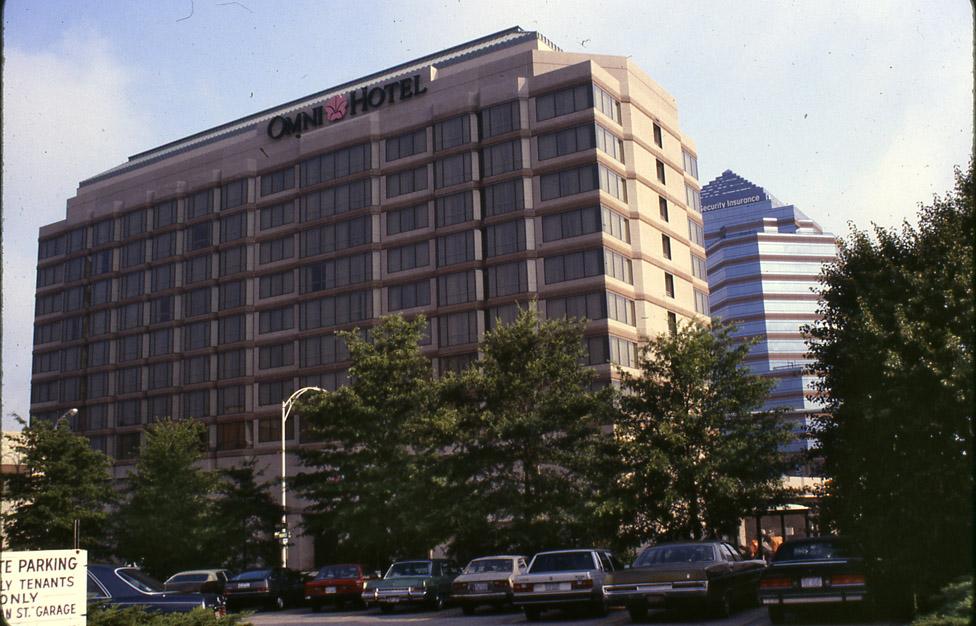
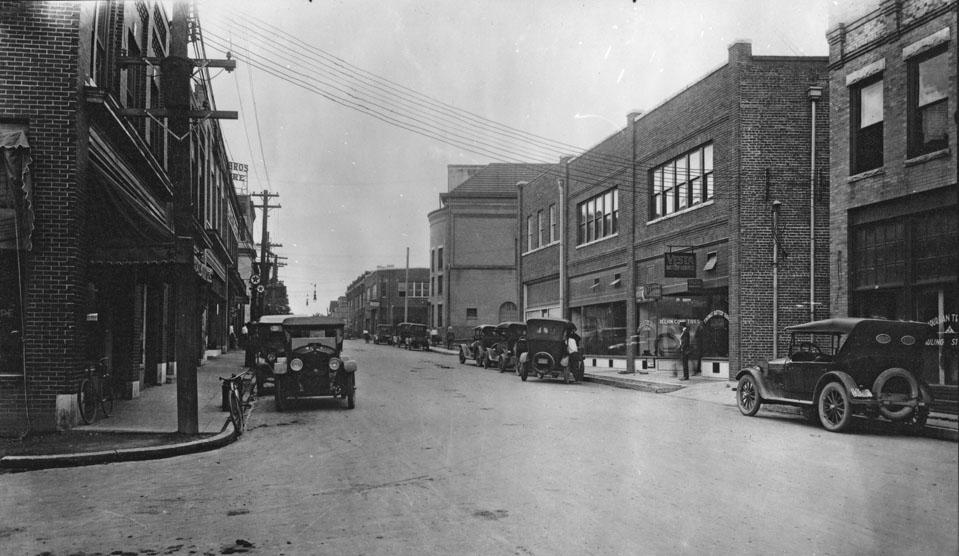
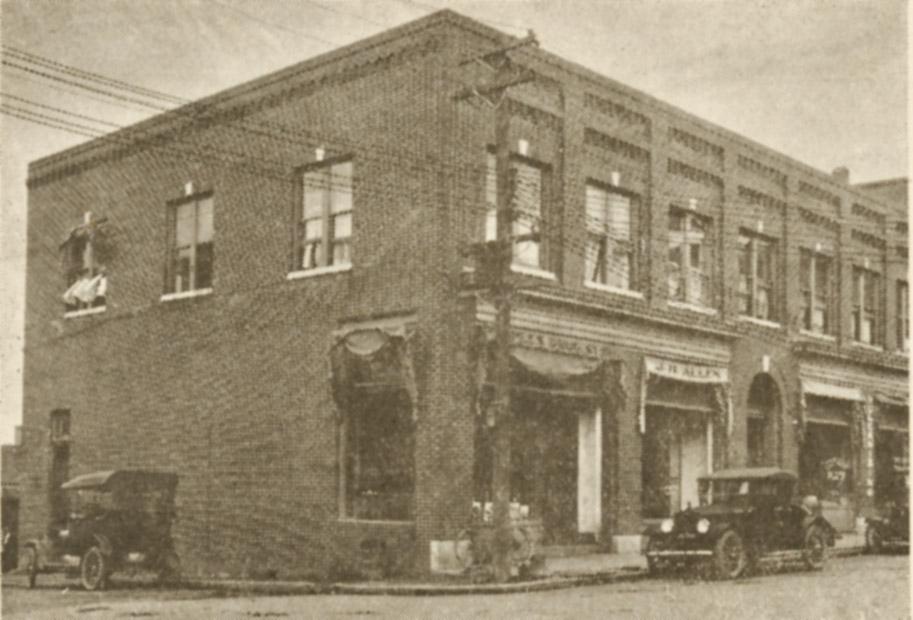
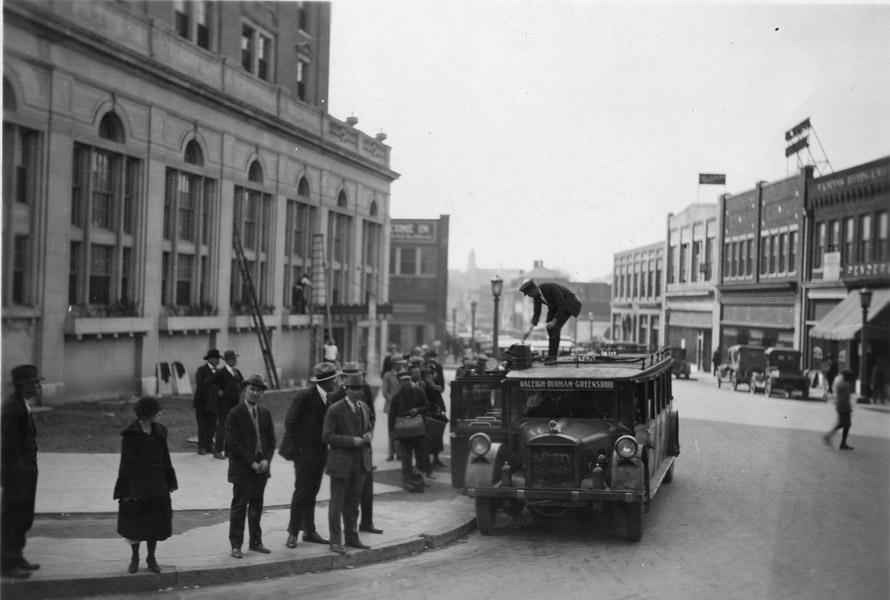
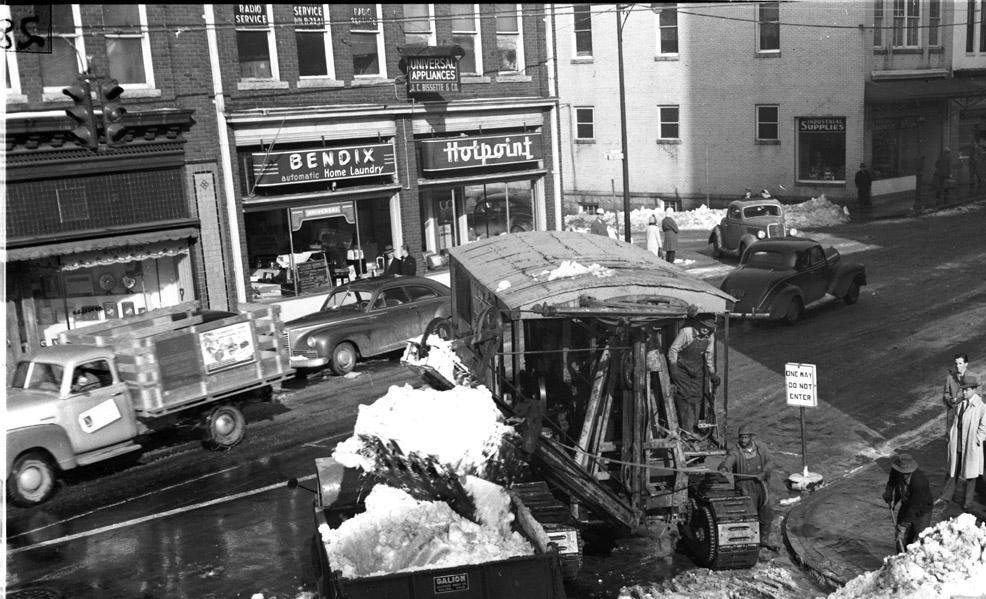

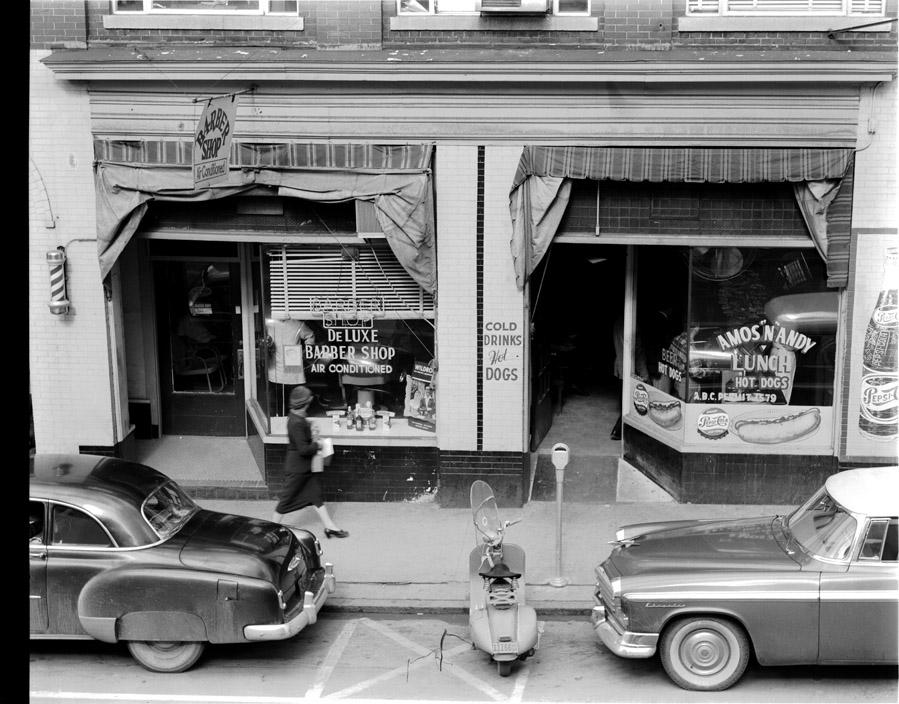
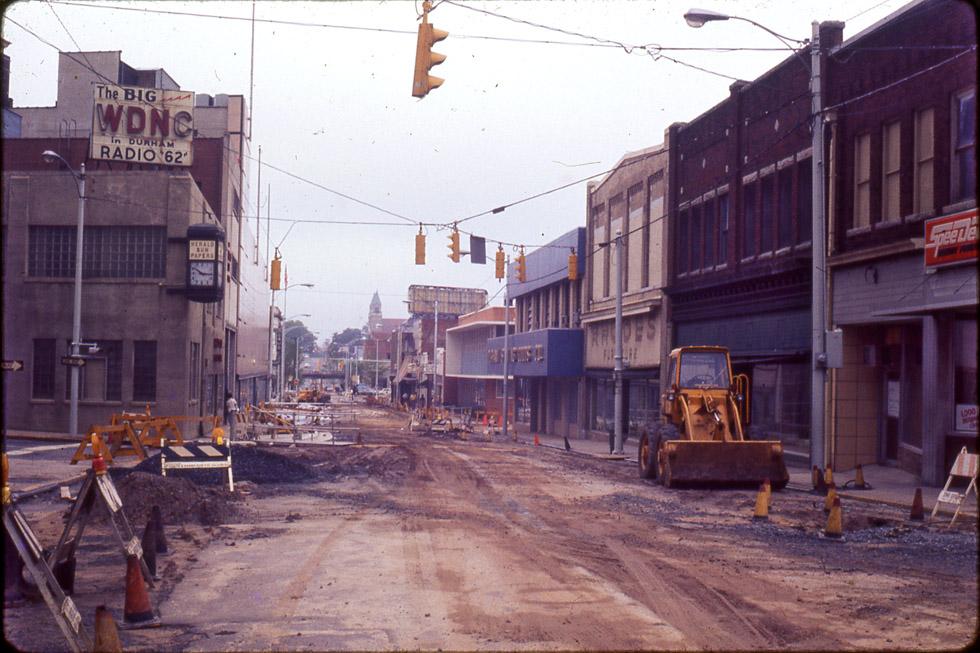
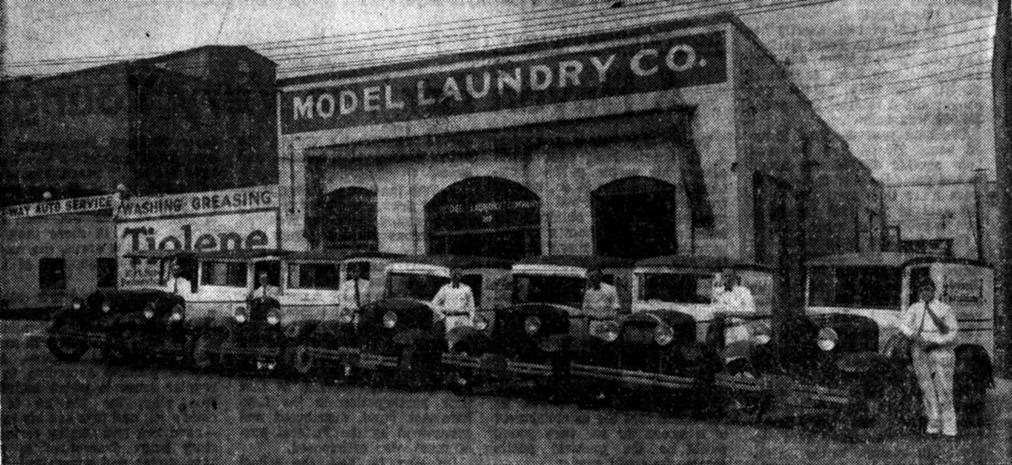
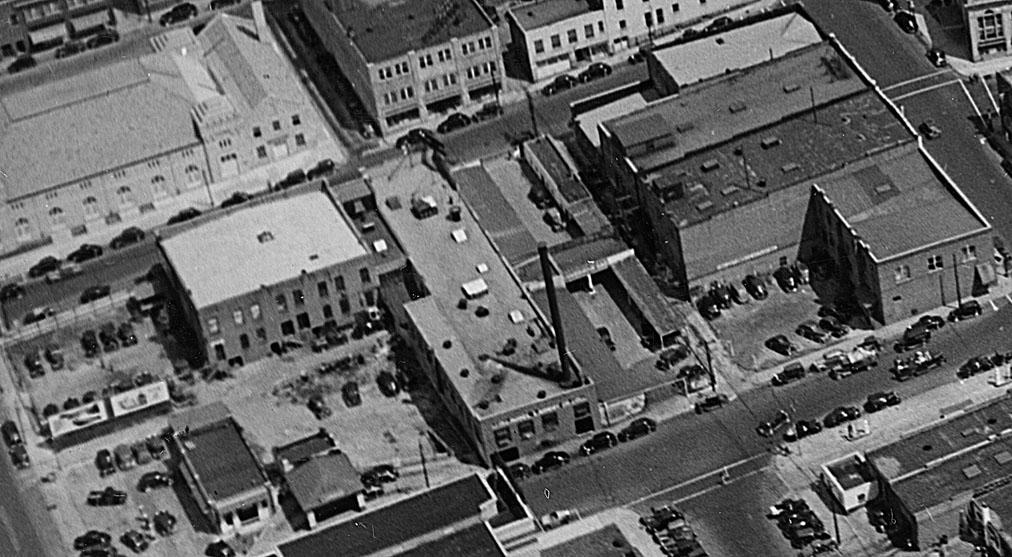
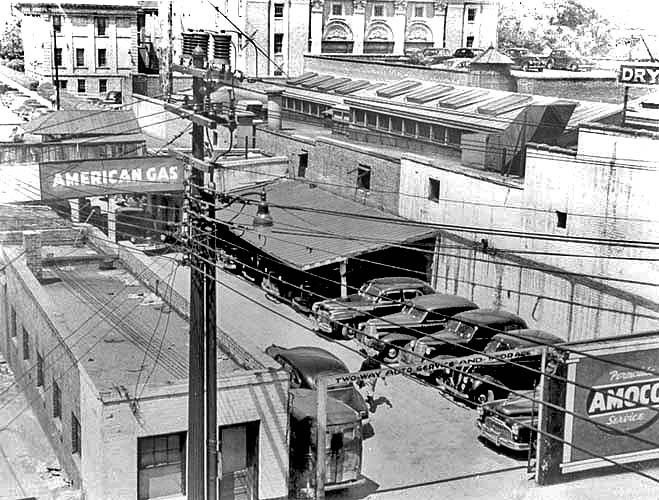
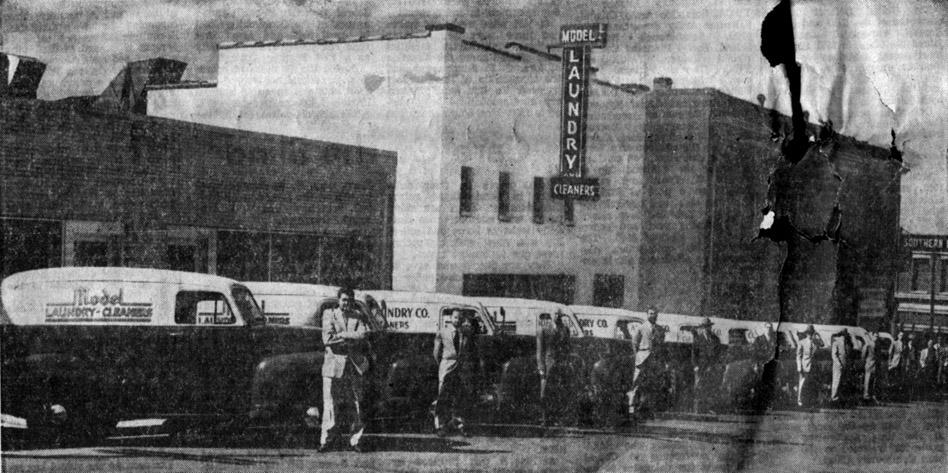
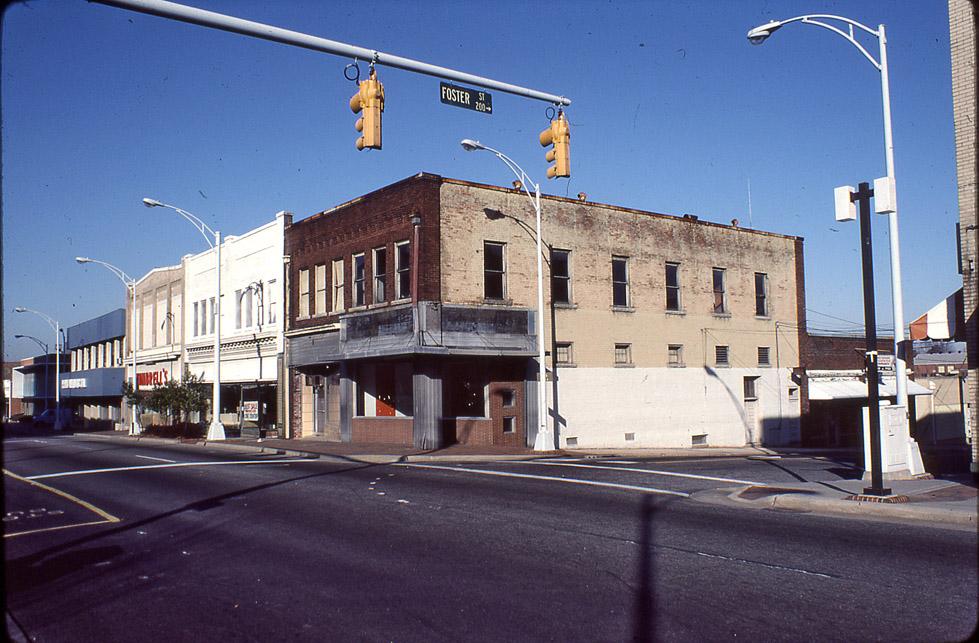
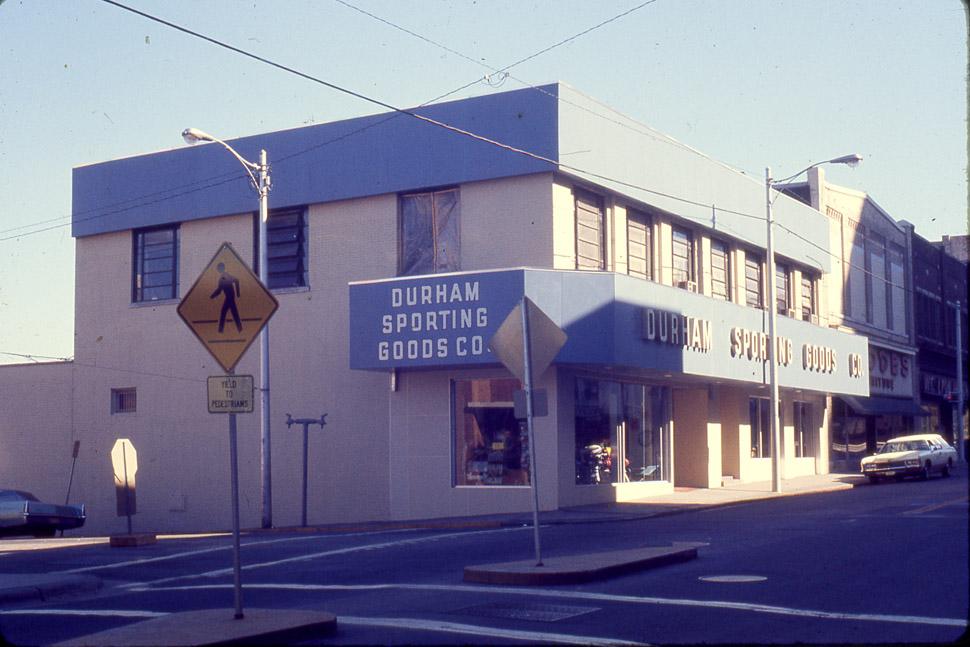
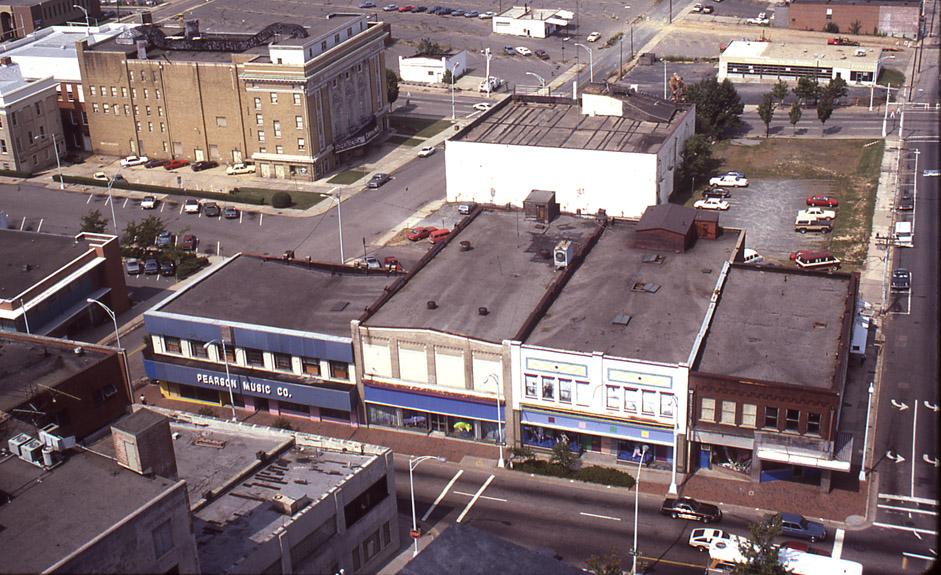
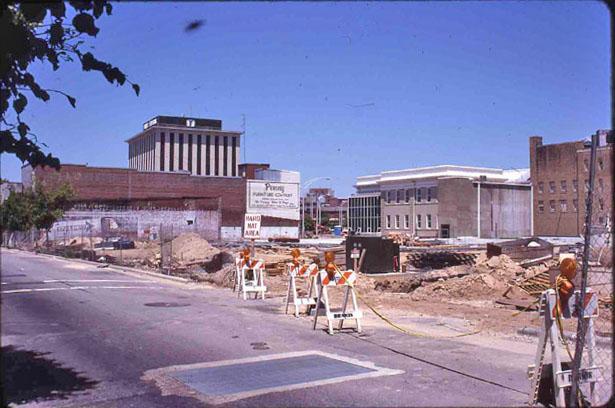
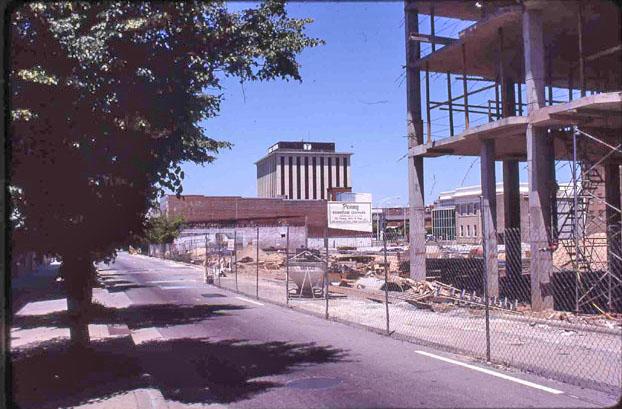

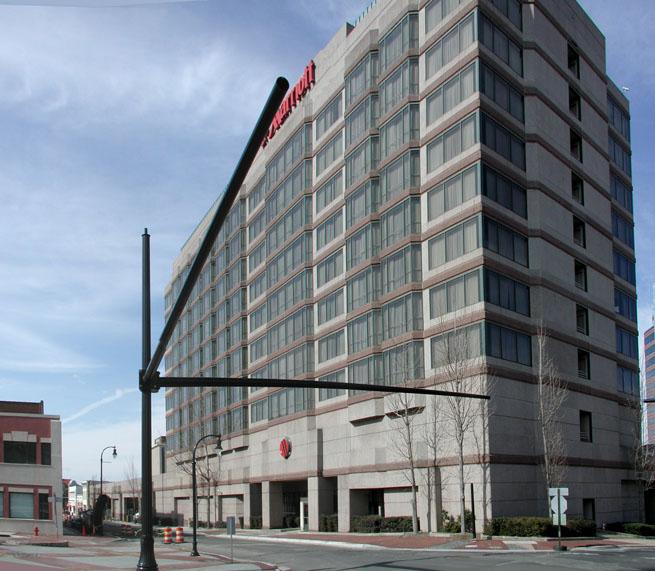
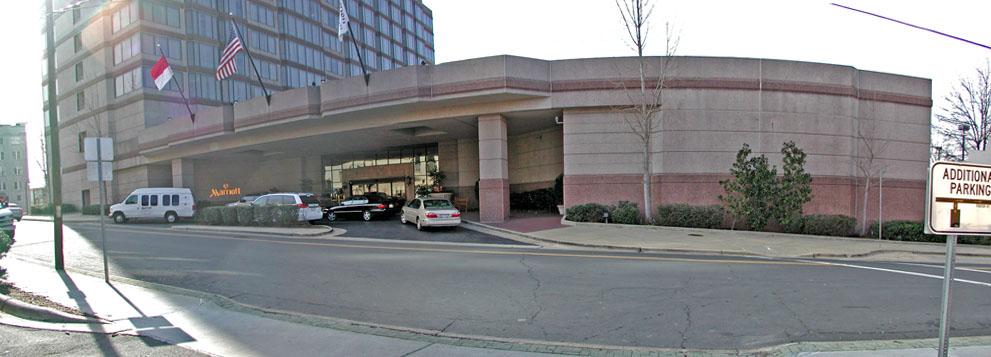

Comments
Submitted by Daniel (not verified) on Wed, 2/14/2007 - 11:20pm
My wife, a long time resident of Durham, tells me that artists were allowed to decorate the block right before it was torn down. She might have a picture of it.
The convention center's loading dock (along with the Bull City Business Center and its loading dock) is indeed one long dead space. I thought I heard a few years back that they were thinking about augmenting or rebuilding the con center. Heard anything about that lately? If they reopened Roney, and moved the dock there, would that work?
Submitted by Gary (not verified) on Wed, 2/14/2007 - 11:37pm
Daniel
Thanks so much for the extra info - I'd love to add a picture of that if she has one.
There are periodic rumblings about the convention center, and how it needs to be upgraded in some way. I don't really know what kind of bookings it has, so I don't know how to gauge its usefulness. I know a lot of cities get spurred into this convention-competition thing, building bigger and bigger facilities to try to attract the bigger shows. That, in my opinion, is the last thing Durham needs to spend money doing. But it has a lot of appeal to the corporate economic development types.
I think, were there a change, there are a lot of ways to improve the whole block - I'll be posting on more of the former Roney St. tomorrow, and I think the plaza is really a dysfunctional space. If someone really felt the need for a new convention center at some point, I'd advocate for the surface lots on Morgan between Rigsbee and the former Holland St. That would give you the most flexibility to put the service entrance along a mid-block alley.
GK
Submitted by Michael (not verified) on Thu, 2/15/2007 - 12:37am
At some point, I really need to write up something about the convention center consultant's report. I can't find the PDFs now, although I'm sure Reyn Bowman would be happy to supply them. There's a lot of stuff to digest in there, and the funny thing is that the "research" portion of the report is really quite fantastic, and builds the best case I can imagine for NOT expanding the civic center downtown, and potentially even tearing down some of it. Of course, this goes straight against what makes it into the "recommendations" and the executive summary, which recommends expansion, of course. (I really need to get those from Reyn...)
For now, though, I want to just share some tidbits of what the report said that I can remember:
- Meeting spaces like this can largely be broken down into a categories of ballrooms, exhibition space, breakout rooms, and board rooms. The biggest amount of space goes into the first two, of course. Here's a quick map of the current configuration.
- The report commented that in general, the real value space in a convention center comes from the ballrooms. Exhibition halls are good for overflow, but as primary space tend to attract lower dollar shows than most convention centeres need.
- The report also looked at the proper ratio of hotel rooms to square footage of event space. Based on national averages and accepted best practices, the Civic Center has more event space per hotel room than it should. (Of course, the recommendation of the report was to build more event space, and somehow "encourage the construction of more hotel rooms.")
Now, when I look at these findings, my reaction is, "Great! We can tear down a bunch of the event space without hurting the Mariott!" Looking at the configuration map above from DCVB's website, imagine if you were to re-open Roney St., which would run right through the back-most ballroom. As for the giant exhibition hall, the report gives ample support for leveling the damned thing. Imagine, then, if we'd been able to convince the City to do this, then build the new DPAC on the footprint where the exhibition hall now stands, with a grand entrance at the corner of Chapel Hill and a now-reopened Roney, right next to the old Carolina. I actually mentioned this several times in get-togethers amongst the theater opponents, but given the timetables involved, it was simply too much to imagine convincing the city of at that point.
If someone really did want to expand the convention center, I'd say look at the report, and extend another set of ballrooms out over the silly plaza. Build another hotel tower on top of that, and put shops and restaurants in the space below it, along Morgan St.
Submitted by Michael (not verified) on Thu, 2/15/2007 - 12:43am
Can't help myself here -- I'm remembering more of the report.
It very clearly said that convention centers don't generate very much pedestrian traffic in the areas around them, compared to other economic incentives, and that "funky" restaurants and local charm were generally not what large meetings look for. They're much more focused on a "safe" environment, with large dining establishments and interesting shopping. Finally, it said that Durham's meeting traffic was probably going to be largely associated with Duke, RTP, and Central, so the city should work to build on these.
Based simply on those criteria, it took me about 5 minutes to come up with a big list of sites that are far superior for a convention center than the current one. Those include:
- The University Ford lot, to attach to American Tobacco
- Along Rennaissance Parkway, with easy access to Southpoint
- Partner with Duke to expand the Washington Duke
- Partner with Duke to build a convention center near the VA and Duke Hospital.
- Partner with the Imperial Center
- Build something near Durham Regional and get a private developer to rehab North Duke Mall
I play basketball with Wib Gulley, who was mayor when the Convention Center was built. He was, by and large, a fantastic progressive mayor. However, the convention center was clearly a mistake. To be fair, nobody really understood how to do downtown redevelopment then. Hindsight 20/20 and all that.
Submitted by Gary (not verified) on Thu, 2/15/2007 - 3:05am
Michael
Thanks so much - you've added a lot of great info here; I've never seen that report, but I'd love to read it sometime. I think you've identified a lot of great options. As I said, I don't really know who is actually booking these spaces. I took my Internal Medicine Board exam in one almost 7 years ago, and I think I went to Edible Arts there, but that's the extent of my knowledge of their programming. I suspect it is a lot of things like that, though - people needing to rent space for a temporary event. Not the sort of thing that is going to feed any other uses downtown.
But I know in the 80s, cities all starting building these convention centers, because that was the latest fad in Saving Downtown. In places that were already significant tourist destinations, it probably functioned, but not on places that people weren't that keen on visiting in the first place.
I know your view on the Performing Arts Center, Michael, but this is part of my concern. Granted, there is much less fabric to mess up down there, but the motivation seems to come from a similar place.
Anyway - thanks for all your additional commentary.
GK
Submitted by dcrollins (not verified) on Fri, 2/16/2007 - 1:50pm
I'll always remember eating at the Omni lunch buffet in 1991 and getting violently ill. My first job out of college was for CCB, working to reconcile commercial loan payments in a grand space on the first floor of the tower -- 20 ft. ceilings and all that.
The only nice thing I have to say about the Marriott is that when the weather is poor it's convenient to walk through the ballroom corridor en route to the Carolina Theater.
Submitted by Marsosudiro (not verified) on Wed, 2/25/2009 - 12:04am
Some of the OMNI HOTEL signage lived on until recently.
When the hotel changed to Marriott in ~1999, the OMNI HOTEL letters came down and sat on the sidewalk. One of the co-owners of Hell bar in Chapel Hill happened to be driving by and did a scramble to see if he could get a "Hell"'s worth out of them.
But by the time he got a van there to pick up letters, they only had and "H' and maybe an "L" left. He got them and had them mounted inside the bar.
Fast forward to 2008/2009. Hell changed hands and the new owner decided to renovate. Sat the letters outside leaning on the fence next to the stairs down to the bar.
When suddenly - KAPOW! One of the sorority members who parked in the adjoining parking lot did a drunken stupid and hit the gas instead of the brakes while parking. Smashed through the fence. Smashed through the wall above the stairs. Sent cinderblocks and the letters flying. Some of the stuff fell down the stairs and would have killed anyone who was walking up at the time.
Cops were called. The sorority member was located in her room, "wha? wha happened?"
Hell soon closed for other reasons. Perhaps for good. But at least no one got hurt, thank Heavens.
Submitted by Anonymous (not verified) on Sun, 3/29/2009 - 10:05pm
The Warren-Strudwick building was the first home of the Carolina Times.
See Harold Kent Boyd, "Louis Austin and the Carolina Times" MA thesis, NCCU 1966, based on interview with Louis Austin.
Submitted by Anonymous (not verified) on Fri, 12/17/2010 - 9:09pm
Glad to see the Amos and Andy's Restaurant photo as it was a favorite of mine growing up in Durham. We'd have to sit on the Coco-Cola crates on end. I remember all those hot dogs on the grill quickly prepared as they were called out to be served. We would stop there every six months after going to the dentist's office in the CCB building. Great memories.
Erik Nygard
Submitted by PR (not verified) on Tue, 11/25/2014 - 3:42pm
i must say i kind of like how they integrated the hotel and the carolina theater with the public plaza. it is generally the type of thing in urban design that invites only the homeless and creates voided space but i have seen it used for great public gatherings, most notably the duke basketball championship rally i attended in 1992. what blights this part of downtown isn't one poor design flaw, it's a domino effect of design flaws back to back to back. if the people's security insurance building didn't have such a blank, forboding facade across morgan it all wouldn't feel so walled-in and impersonal. it's invigorating to see what raleigh has done in revitalizing old retail streets like blount and wilmington but disappointing to see that durham bulldozed so many similar thoroughfares to build these modern, quickly obsolete structures.
Add new comment
Log in or register to post comments.